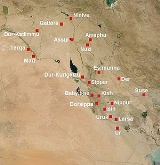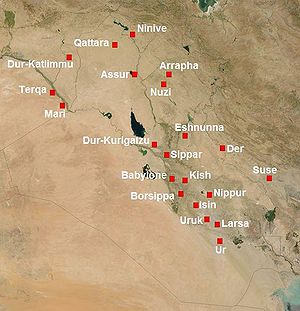
Borsippa
Encyclopedia

Sumer
Sumer was a civilization and historical region in southern Mesopotamia, modern Iraq during the Chalcolithic and Early Bronze Age....
, built on both sides of a lake about 17.7 km (11 mi) southwest of Babylon
Babylon
Babylon was an Akkadian city-state of ancient Mesopotamia, the remains of which are found in present-day Al Hillah, Babil Province, Iraq, about 85 kilometers south of Baghdad...
on the east bank of the Euphrates
Euphrates
The Euphrates is the longest and one of the most historically important rivers of Western Asia. Together with the Tigris, it is one of the two defining rivers of Mesopotamia...
. The site of Borsippa is in Babil Governorate, Iraq
Iraq
Iraq ; officially the Republic of Iraq is a country in Western Asia spanning most of the northwestern end of the Zagros mountain range, the eastern part of the Syrian Desert and the northern part of the Arabian Desert....
and now called Birs Nimrud, identifying the site with Nimrod
Nimrod
Nimrod means "Hunter"; was a Biblical Mesopotamian king mentioned in the Table of Nations; an eponym for the city of Nimrud.Nimrod can also refer to any of the following:*Nimród Antal, a director...
. The ziggurat
Ziggurat
Ziggurats were massive structures built in the ancient Mesopotamian valley and western Iranian plateau, having the form of a terraced step pyramid of successively receding stories or levels.Notable ziggurats include the Great Ziggurat of Ur near Nasiriyah, Iraq; the Ziggurat of Aqar Quf near...
, the "Tongue Tower," today one of the most vividly identifiable surviving ziggurats, is identified in the Talmud and Arab culture with the Tower of Babel
Tower of Babel
The Tower of Babel , according to the Book of Genesis, was an enormous tower built in the plain of Shinar .According to the biblical account, a united humanity of the generations following the Great Flood, speaking a single language and migrating from the east, came to the land of Shinar, where...
.
The local god was Nabu
Nabu
Nabu is the Assyrian and Babylonian god of wisdom and writing, worshipped by Babylonians as the son of Marduk and his consort, Sarpanitum, and as the grandson of Ea. Nabu's consort was Tashmetum....
, called the "son" of Babylon's Marduk
Marduk
Marduk was the Babylonian name of a late-generation god from ancient Mesopotamia and patron deity of the city of Babylon, who, when Babylon became the political center of the Euphrates valley in the time of Hammurabi , started to...
, as would be appropriate for Babylon's lesser sister-city.
History
Borsippa is mentioned, usually in connection with Babylon, in texts from the Ur IIIUr
Ur was an important city-state in ancient Sumer located at the site of modern Tell el-Muqayyar in Iraq's Dhi Qar Governorate...
period through the Seleucid period and even in early Islamic texts. Borsippa was dependent upon Babylon and was never the seat of a regional power. From the 9th century BCE, Borsippa was on the borderland south of which lay the tribal "houses" of Chaldea
Chaldea
Chaldea or Chaldaea , from Greek , Chaldaia; Akkadian ; Hebrew כשדים, Kaśdim; Aramaic: ܟܐܠܕܘ, Kaldo) was a marshy land located in modern-day southern Iraq which came to briefly rule Babylon...
.
The temple to Nabu at Borsippa was destroyed in 484 BCE during the suppression of a revolt against the Achaemenid king Xerxes
Xerxes
Xerxes is a male name. Most notably, it may refer to Xerxes I of Persia . It may also refer to:-People:*Xerxes II of Persia, reigned 424 BCE*Xerxes of Armenia, Armenian king, assassinated around 212 BCE...
Archaeology
In 1854 work at Borsippa was conducted under the direction of Henry Creswicke Rawlinson, with most of the actual digging done by his subordinates.Rawlinson personally uncovered the foundation prisms from Nebuchadnezzar IIs restoration on the Nabu temple.Between 1879 and 1881 the site was excavated by Hormuzd Rassam
Hormuzd Rassam
Hormuzd Rassam , was a native Assyrian Assyriologist, British diplomat and traveller who made a number of important discoveries, including the clay tablets that contained the Epic of Gilgamesh, the world's oldest literature...
for the British Museum
British Museum
The British Museum is a museum of human history and culture in London. Its collections, which number more than seven million objects, are amongst the largest and most comprehensive in the world and originate from all continents, illustrating and documenting the story of human culture from its...
.
He concentrated primarily on Ezida, the temple of Nabu. In 1902, Robert Koldewey worked at Borsippa during his main effort at Babylon
Babylon
Babylon was an Akkadian city-state of ancient Mesopotamia, the remains of which are found in present-day Al Hillah, Babil Province, Iraq, about 85 kilometers south of Baghdad...
also mainly on the Nabu temple.
Since 1980, the Austria
Austria
Austria , officially the Republic of Austria , is a landlocked country of roughly 8.4 million people in Central Europe. It is bordered by the Czech Republic and Germany to the north, Slovakia and Hungary to the east, Slovenia and Italy to the south, and Switzerland and Liechtenstein to the...
n team from the Leopold-Franzens-Universität Innsbruck
Leopold-Franzens-Universität Innsbruck
University of Innsbruck has been a university in Austria since 1669.It is currently the largest education facility in the Austrian Bundesland of Tirol and third largest in Austria according to student population, behind Vienna University and the University of Graz.-History:In 1562 a Jesuit grammar...
led by Helga Piesl-Trenkwalder and Wilfred Allinger-Csollich excavated for sixteen seasons at the site. Early work
concentrated on the large ziggurat E-ur-imin-an-ki and later on the Nabu temple. Excavations can currently not be carried out due to political events. The elaboration of the results of excavations within the project "Comparative studies of Borsippa - Babylon" are conducted.
Many legal administrative and astronomical texts on cuneiform
Cuneiform script
Cuneiform script )) is one of the earliest known forms of written expression. Emerging in Sumer around the 30th century BC, with predecessors reaching into the late 4th millennium , cuneiform writing began as a system of pictographs...
tablets have originated at Borsippa and have turned up on the black market. Archives began to be published in the 1980s. An inscription of Nebuchadrezzar II
Nebuchadrezzar II
Nebuchadnezzar II was king of the Neo-Babylonian Empire, who reigned c. 605 BC – 562 BC. According to the Bible, he conquered Judah and Jerusalem, and sent the Jews into exile. He is credited with the construction of the Hanging Gardens of Babylon and also known for the destruction...
, the "Borsippa inscription," tells how he restored the temple of Nabu, "the temple of the seven spheres," with "bricks of noble lapis lazuli
Lapis lazuli
Lapis lazuli is a relatively rare semi-precious stone that has been prized since antiquity for its intense blue color....
." that must have been covered with a rich blue glaze, surely a memorable sight. The Austrian archeologists have determined that Nebuchadnezzar's ziggurat encased the ruins of a smaller tower from the second millennium BCE. When it was completed it reached a height of 231 feet, in seven terraces; even in ruin it still stands a striking 172 feet over the perfectly flat plain. Some tablets
Clay tablet
In the Ancient Near East, clay tablets were used as a writing medium, especially for writing in cuneiform, throughout the Bronze Age and well into the Iron Age....
have been recovered, but archeologists still hope to uncover a temple archive of cuneiform tablets, of which there were some copies in ancient Assyria
Assyria
Assyria was a Semitic Akkadian kingdom, extant as a nation state from the mid–23rd century BC to 608 BC centred on the Upper Tigris river, in northern Mesopotamia , that came to rule regional empires a number of times through history. It was named for its original capital, the ancient city of Assur...
n libraries. An inscribed foundation stone has been recovered, which details Nebuchadnezzar's plan to have the Borsippa ziggurat built on the same design as that at Babylon, of which only the foundation survives. Nebuchadnezzar declared that Nabu's tower would reach the skies, another inscription states. The reconstruction under the patronage of Bel-Marduk is summarized on a cylinder in Akkadian of Antiochus I, an example of the region's remarkable cultural continuity.

